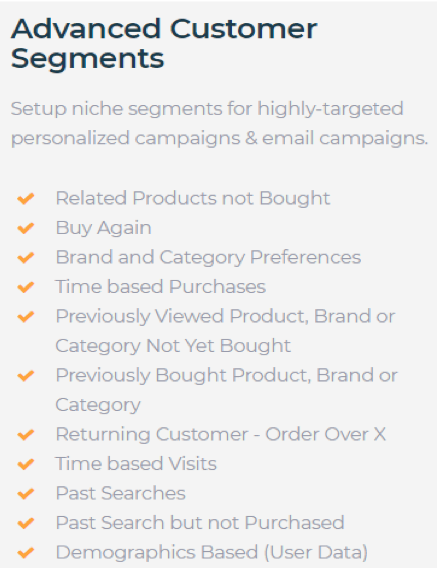7 Fixes for Common Personalization Pitfalls
Personalizing your site is one of the most effective ways to transform your site from a flat, static platform to a live, dynamic and responsive tool for your customers to find exactly what they need. However, with so many tools and features out there it can be tricky to focus on what the best practice is. I’ll discuss seven of the most common personalization pitfalls that it’s easy to fall into nowadays. The good news is, they’re all very easy to fix!
1. Ignoring your data
Now, more than any other time in history, big data is king. There’s so much information about almost every aspect of online shopping right at your fingertips. The only issue is that it’s all variable quality. It can be easy to get overwhelmed in the sheer volume, and not know what is best to focus on.
The fix: determine ahead of time what your goals are and identify the kinds of data which help you to track and address them. For example, if you want to focus on optimizing your site search, keep an eye on what people are searching for leading to good results (conversion) and bad results (either no results on search, or a bounce). If you are confident in your goals, you can make the data work for you.
2. Personalization burnout
We’re all guilty of this: signing up to too much to reasonably manage. Sometimes when exposed to brand new tools and exciting opportunities, it can be tricky to avoid trying every functionality out. However, even though the possibilities of personalization are endless, your time and resources are not. Too many people start on many different projects but then can’t find the time to finish them up. It’s important to avoid getting tired and burned out of personalization.
The fix: start small and build on that. See what works and tailor your effort accordingly. It sounds basic but it’s so key to building a sound personalization strategy and accomplishing your goals. Whether you use an online planning tool, or go old-school by using pen and paper, plan out how you’ll personalize on ever-increasing levels. Create a base layer of personalization for everyone, and then go more niche. This ensures you have a net of personalization that catches and then focuses in on each person, giving them a unique and personalized experience on your site.
3. Relying on AI
Everyone’s heard that machines will someday take over the world, and perhaps it’s true! However, for now, although Artificial Intelligence and Machine Learning are becoming ever-more intelligent and capable, there’s nothing that replaces good old-fashioned industry know-how. An algorithm will not know your customers, your products, and how they all interact together the way you do. Many companies rely exclusively on AI to tend to their customers. While this saves a lot of time and energy, it can be even more rewarding and effective to get hands-on with personalization, targeting those niches only you know exist.

The fix: Use your own expertise to inform your personalization efforts. Create custom content, use branded imagery, or even just set up manual recommendations to people you just know will love a particular product. Your customers will appreciate the efforts you go to, making sure your site is a way for them to explore, discover, and enjoy a unique shopping experience. Let the AI give you the trends and insights to give you the foundation to build.
4. Not using real-time personalization
One of the most powerful ways to personalize is by using real-time data. The result is a site that practically lives and breathes with your customers. Many online stores rely solely on historical data to personalize, that is, data from previous visits, rather than data which is being presented to the site in the present. Ignoring real-time data really misses a trick to have a site that reacts in real-time to customer information and behaviour.

The fix: Use data like time of day, location, and even weather to customize what your customers are seeing. You can use the ways your customers interact with the site to personalize their journey, reacting to what they have in their basket, their basket value, even what they’re looking at now. Real-time data gives you up-to-date trends, offering opportunities to sell now, rather than to miss the boat as you would if only relying on historical data. This gives the customer a seamless, dynamic experience.
5. Stagnating
Part of what makes personalization so influential on your customers is that it changes as their relationship with your site changes. When they act in certain ways, the site alters to become better for them. However, this requires active management of your personalization efforts. If you set it all up and then let it sit without further involvement, it’s possible your site will lose that fresh, dynamic feel that makes it so enticing to your customers.
The fix: invest in a personalization tool that comes equipped with a comprehensive analytics tool and keep a watchful eye on the results of your personalization efforts. Note what works, course-correct what doesn’t work, and always build on the layers of personalization you have. For example, you can push the latest products that have been selling well, you can clear stock, theme your products, or do seasonal offerings. Even if it’s just five to ten minutes a week, this small effort can massively improve performance. Use the tools at your disposal and make your personalization the most effective it can be by keeping up with the results.
6. Missing out on microtargeting opportunities
Marketing campaigns can be painted in broad strokes: first-time visitor campaigns, sale campaigns, and other wide-reaching campaigns are very popular. However, they’re not unique. By sticking to generic campaigns, you miss out on giving your customers what they’re looking for.

The fix: There’s a reason why customers are coming to your site. Capitalize on that by cutting through the general noise of marketing and providing niche, specific offerings to those who will appreciate it. For example, if someone adds an expensive, high-end camera to their basket, why not offer them a camera case to protect their new camera? By using behaviour-based microtargeting, you can show the right products to the right people, increasing conversion rates across the board.
7. Thinking of Personalization as an add-on accessory
Finally, one of the e-commerce personalization pitfalls that businesses can fall into is to treat personalization as a mere add-on. It’s not just an accessory to your online business, it’s a transformative process and tool that can uplift your site and turn it into a place where your customers can explore, discover, and ultimately find something that’s just right for them.
The fix: integrate whatever personalization tool you use across your site and across all your channels with omnichannel options. Give consistent personalization options on all conversion points across your site and off-site, from the landing page to the till receipt. While personalization can just be tacked on to a few points, why limit yourself when so much more is possible? Offer consistent, useful personalized points across all facets of your store to reap the rewards of personalization.
To find out how PureClarity can help you establish an effective e-commerce personalization strategy visit https://www.pureclarity.com/request-a-demo/